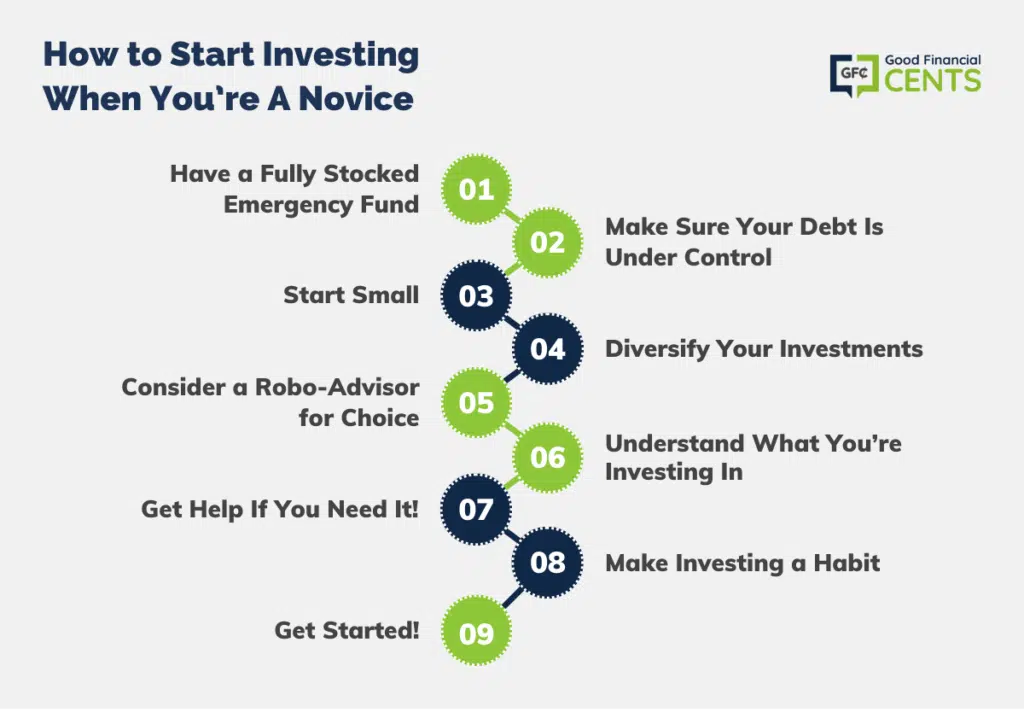One of the biggest reasons why people don’t invest is because they don’t completely understand the process.
We’re here with our Investing for Dummies Guide, to help you get over the hurdle.
(Don’t take it personally – we’ve all been dummies at investing at one time or another!)
Even if you’re absolutely clueless, the most important step with investing is just getting started.
In reality, you don’t have to be a complete expert before you get started either.
It may help to know that no one is a true expert, not even the talking heads in the financial media, or people who have been investing for decades.
People make investing mistakes all the time, and you will, too.
But what matters most is not getting hung up on those mistakes.
What’s most important is that you’ll make mistakes, fix them, then keep moving forward.
So, let’s move forward.
Beginner’s Guide to Investing
How to Start Investing When You’re A Novice
Table of Contents
True investing isn’t a get rich quick scheme. Instead, it’s a long-term process that usually takes decades to see the best results. That’s why it’s so important to begin investing now, even if you don’t fully understand the process.
We’ll break it down, starting with showing you how to prepare your finances for investing.
Then we’ll give you some solid strategies that will help you up your game as you go along.
You may never be a complete expert, but you’ll know enough to get started after reading this article.
Expert status – if it’s even possible – will come with time.
Step 1: Have a Fully Stocked Emergency Fund
Probably the scariest scenario in the investment universe is watching your investments fall in value, at a time when you need the money for other purposes. But like everything else when it comes to investing, there’s a fix.
It’s called an emergency fund. An emergency fund is a completely safe, completely liquid financial account, that enables you to access the funds anytime you need them, and on very short notice.
There are two major purposes for an emergency fund:
- To have ready cash to cover an unexpected expense, and
- to prevent you from needing to liquidate investment assets to cover that expense.
Put another way, an emergency fund serves as a protective buffer between your budget and your investments. It prevents you from having to liquidate investments at prices that might lock in a permanent loss.
An emergency fund accomplishes something else that’s very important. It gives you sleeping money.
What’s sleeping money? The financial markets don’t always behave the way we expect them to. Sometimes they languish for what seems like forever. Other times there’s a lot of volatility, with the market swinging back and forth in unpredictable patterns.
And sometimes there’s a bear market, causing stocks to drop for several years. If you’ve got money sitting in a safe emergency fund, you won’t be as concerned about the ups and downs of the market. You’ll be able to sleep at night. Where should you hold your emergency fund?
We like online banks that pay high rates on savings, money markets, and certificates of deposit (CDs). Examples include:
Any of these banks keep your money safe, completely liquid, and pay interest rates well above local banks.
Step 2: Make Sure Your Debt Is Under Control
There are some who will say you should start investing no matter what your financial situation is, even if you have a lot of debt. This is not a completely ridiculous concept.
It has to do with the time value of money – the sooner you begin investing, the more time your money will have to grow.
Simply put, you’ll have more money accumulated if you begin investing at 25 than if you start at 40. That’s the argument to begin investing no matter what your financial situation is. But while that strategy makes sense in a lot of situations, you also have to look at the math. Consider the following:
- Interest: The average interest rate on credit cards is 20.69%.
- Returns: The historic return on the S&P 500 is about 10% since 1928.
- Reality: Even with 100% of your investments in the stock market, earning 10%, you’ll be losing 7% each year with an equivalent amount of credit card debt.
If you have a lot of credit card debt, you can see how this will work against you. That’s an arrangement you’re doomed to lose.
Now that doesn’t mean you need to be absolutely credit card free. If you have relatively small balances, there’s no reason to wait until you pay off the last dollar.
But if you have several thousand dollars in credit card debt, you must consider what a losing proposition that is. The better strategy will be to pay off the bulk of your credit cards before investing.
When it comes to investing, credit card debt is like a backdoor margin loan, but at rates so high as to defeat the purpose.
What About Other Types of Debt?
Other types of debt, like student loans and auto loans, are trickier. Student loans can run for 10, 15, or 20 years. That’s too long to wait to begin investing.
And car loans makes sense because they are secured by an asset that’s used to help you earn an income – your car.
And no, you shouldn’t wait to pay off your mortgage completely before you begin investing.
It’s long-term debt, like student loans, and it’s secured by an asset that provides a direct benefit, similar to a car loan. If you wait for these loans to be paid off, you may never begin investing.
Step 3: Start Small
Probably the biggest reason people don’t begin investing sooner is a lack of money.
But in today’s investment universe, a lack of money isn’t a serious problem. There are any number of investment platforms that will enable you to begin investing with very little money, or even none at all.
Betterment
For example, probably the best known of all robo-advisors is Betterment. You can sign up for an account with them, and you don’t need any money at all.
You can fund your account gradually, through regular monthly deposits. If you can contribute at least $100 per month, you’ll be surprised how quickly the account will build up.
Sign up with Betterment today >>
And as investment earnings increase your account value, you’ll begin to see the power of that time value of money concept in action.
Acorns
Another investment app that’s become increasingly popular – and will also enable you to begin investing with no money – is Acorns. It’s a smartphone app you attach to your bank account or credit card.
As you spend money the way you regularly do, Acorns will make small contributions toward an investment account.
For example, let’s say you purchase a latte at Starbucks for $4.50. The app will charge your bank account or credit card $5 even. $4.50 will pay Starbucks, and 50 cents will go into your investment account.
What’s more, the investment account is a robo-advisor. As money goes into the account, it will automatically be invested in a diversified portfolio.
From there, it will be fully managed, including periodic rebalancing to maintain the asset allocation, as well as reinvestment of dividends.
This is also how Betterment works, so you really can’t go wrong with either account. With each, you’re starting very small, then building up over time. Perfect!
Start investing with Acorns here >>
Step 4: Diversify Your Investments
A common mistake many new investors make is putting all their money into a very small number of stocks, or maybe even one. The theory is if that one stock takes off, you’ll become an instant millionaire. Sorry to burst your bubble, but that only works on TV.
In the real world of investing, you need to build a diversified portfolio. That means owning many different stocks, spread across different industries.
You’ll also want to counter your stock holdings with fixed-income investments. These will typically consist of bonds, but it could also be CDs held at an online bank.
The basic idea is that if the stock market starts misbehaving, your fixed income allocation will remain safe.
For a small investor, it can be very difficult to diversify. After all, it takes a lot of money to buy a lot of different stocks. But that’s another problem the investment industry has overcome.
We’ve already discussed robo-advisors like Betterment and Acorns. They’ll automatically create a balanced portfolio of stocks and bonds for you. This will spare you the trouble of having to create a portfolio yourself.
And since you’re investing flat dollar amounts, even a small investment can be spread across literally hundreds of different investments.
Step 5: Consider a Robo-advisor that Let’s You Choose the Investments
Eventually, you may get the confidence and knowledge, so you feel comfortable selecting at least some of your own investments. If you do, there’s an investment app for you. M1 Finance is a robo-advisor, but one that will give you a choice as to what you will hold in your portfolio.
Here’s a quick breakdown of what M1 has to offer:
- Minimum: With as little as $500, M1 creates you a theme-oriented portfolio
- Portfolio: Referred to as “pies,” they are comprised of stocks and exchange-traded funds (ETFs).
- Advantage: You can choose the type of pie you want to invest in from 60 pie templates, or create your own.
- Pies: Can be based on a specific investment sector or even a certain group of stocks.
- Automated management: M1 then takes over and manages your portfolio for you. You choose your investments, but they handle the day-to-day management.
M1 Finance is an excellent platform to begin self-directed investing with. As you find yourself becoming more successful and confident in your investing activities, you can begin building your own pies from the ground up.
And just as important, M1 Finance has no fees. You may not start out with this platform, but you may want to get there eventually.
Start investing with M1 Finance>>
Step 6: Understand What You’re Investing In
Once again, it has to be emphasized that you should use robo-advisors if you’re a new investor. The advantage with robo-advisors is that you don’t need any investment knowledge whatsoever to participate.
As a new investor, you should never invest in anything you don’t understand. The advantage with robo-advisors is that they will both design and manage your portfolio for you. That’s especially important when you’re just starting out and don’t have much capital to invest.
But eventually, you may want to begin do-it-yourself investing. If you do, be sure to ease into it slowly.
It may be best to start with a base of investments in robo-advisors. Or you can even consider holding one or two mutual funds or exchange traded funds.
Each represents a portfolio of dozens or hundreds of stocks, so you don’t have to get involved in either the selection or the managing of those securities. Beyond a robo-advisor, or a fund or two, you can open up a self-directed account with a diversified brokerage firm.
Ally Invest
Let’s take a look at one of our top brokerages, Ally Invest. Here are a few quick facts:
- Investment options: individual stocks, bonds, options, and even mutual funds or ETFs.
- Flexibility: You can use the investment platform for your do-it-yourself investing, while holding your managed money with robos and funds.
- Diversity: A platform like Ally Invest will give you the tools to learn more about investing, as well as individual securities. But it also provides tools to help you be a better investor.
But once again, move slowly with this process. You can lose a lot of money jumping in too quickly.
Step 7: Get Help If You Need It!
If you want to get into self-directed investing, but you don’t feel you’re quite ready, there are plenty of places where you can get help.
Some are free, but others charge a fee.
But if you plan to be a successful investor, you’re eventually going to have to start paying some fees for more advanced services.
You should think of investing like running a business. You’re running the business to earn money, but sometimes you have to re-invest in the business so you can earn more money. The concept is similar with investing.
Here are few resources that can help you along the way:
- Bloomberg and MarketWatch: You should become a regular reader of sites like Bloomberg and MarketWatch. They’ll keep you up-to-date with what’s going on in the financial markets and offer a wealth of information on the companies you’ll want to invest in. Investing is largely a process of building a knowledge base, and you’ll need to do that gradually and consistently.
- Morningstar: If you want more information about individual securities, particularly funds, you can look into services like Morningstar. You’ll pay for the service, but the information is virtually a standard in the investment world. If you’re serious about becoming a do-it-yourself investor, you’ll need this kind of resource.
- Personal Capital: There’s also a way you can get hands-on investment assistance at a relatively low rate. A platform known as Personal Capital offers a wealth management service. The service functions like a robo-adviser, but also provides you with big picture financial advice, to help you manage your entire financial life.
Step 8: Make Investing a Habit
Investing isn’t something you do once, or even occasionally. Your success is directly tied to how consistently you do it. That means not only making regular contributions to your investments, but also making sure you’re invested in all types of markets.
Let’s look at the impact regular contributions have on investing… If you invest $10,000 into a portfolio that averages 7% per year, for the next 30 years, it will grow to about $76,125.
But let’s say instead of making a one-time investment of $10,000, you contribute $5,000 each year, for 30 years – also earning an average annual rate of return of 7%.
After 30 years you’ll have over $490,000! There’s another benefit to regular periodic investment, and that’s dollar cost averaging. It’s one of the most time-honored concepts in investing.
When you make a one-time investment, you’re buying into the market at whatever prices are at that time.
If you make a $10,000 investment, and the market falls 50% in the next year, you’ll be down to $5,000. But by making regular contributions, into all types of markets, you’re never worried about where the market is at. In some years you’ll be investing at what’s considered to be a bad time.
In others you’ll be investing in what’s considered a good time. But by making regular contributions, you remove the guesswork. You’re investing in all types of markets, and your focus is completely on the long-term performance of your portfolio, and not in any attempts to time the market.
That’s important, because no successful market timing strategy has ever been developed. And by making regular contributions, you won’t need one anyway. When it comes to investing, consistency is more important than timing.
Step 9: Get Started!
None of this information matters if you don’t put it into action. The critical first step with investing is always to begin. You don’t need much money to do that, or even any money at all.
You can either open an investment account with just a few dollars, or open one with zero and set up regular contributions.
Those contributions will help you gradually build a growing investment portfolio through dollar-cost-averaging. In that way you won’t have to worry about what the market is doing at the time you invest.
Since you’ll be investing regularly, you’ll be investing in all types of markets, at all price levels.

Don’t Let Lack of Knowledge Stop You
There are plenty of investment apps and investment information services to will help you become a successful investor, even though you’re just starting out–hey, maybe you can call yourself an apprentice now, at a minimum!
Some will even fully manage your investments for you, and at a surprisingly low cost.
And once you’re ready to begin trying your hand at self-directed investing, go slowly.
Make sure you have a solid base of emergency savings and managed investment accounts.
Then gradually move into self-directed investing on a diversified investment platform, one with all the tools you’ll need to be a successful investor.
At some point you may even decide self-directed investing isn’t your thing, and that’s fine.
Very few people could remotely qualify as investment experts, so you’re in good company if you’re not one of them.
But you can still take advantage of managed accounts, like Betterment, to handle the work of investing for you.
The only requirements are a willingness to get started, and a decision to commit to the long-term, and you’ll have everything you need to be a successful investor.
Final Thoughts – Investing for Dummies
In the realm of investing, lack of understanding often holds people back. Overcoming this hurdle is the essence of our Investing for Dummies Guide. Investing, a long-term process, need not be intimidating. Initiation is paramount.
Even without expert knowledge, stepping into investment is crucial. Remember, no one is infallible; even seasoned investors make errors. However, dwelling on mistakes is counterproductive.
The key is acknowledging missteps, rectifying them, and moving onward. Progression is the crux. From building an emergency fund to controlling debt, starting small, diversifying, comprehending investments, and seeking assistance when necessary, this guide empowers novices to embark on an investment journey with confidence.







